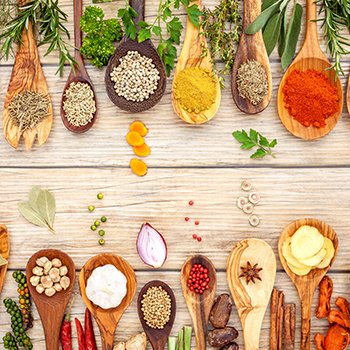ภูมิปัญญาผลิตภัณฑ์สมุนไพรกับกฎระเบียบการใช้งาน Wisdom of Herbal Product: Utilization and Regulations
566 Views |

By: ดร. ดลพร ว่องไวเวช
Donporn Wongwaiwech, Ph.D.
คณะวิทยาศาสตร์และเทคโนโลยีการเกษตร
มหาวิทยาลัยเทคโนโลยีราชมงคลล้านนาตาก
donporn@rmutl.ac.th
ปรีชาพร เกตุแก้ว
Preechaporn Katekaew
สาขานิติศาสตร์ คณะมนุษย์ศาสตร์และสังคมศาสตร์
มหาวิทยาลัยราชภัฏนครศรีธรรมราช
preechaporn_kat@nstru.ac.th
สมศักดิ์ ทะระถา
Somsak Tharatha
Senior Vice President and General Manager, Chiangmai Branch
Central Laboratory (Thailand) Co., Ltd.
sci.somsak@gmail.com


ตัวอย่างพืชสมุนไพรและสารสำคัญที่มีประโยชน์ต่อสุขภาพ
1. ขมิ้นชัน (Turmeric) ในปัจจุบันขมิ้นชันถูกนำมาใช้ในผลิตภัณฑ์อาหารหลากหลายรูปแบบ อาทิ การนำเหง้าสดไปใช้ในการประกอบอาหาร แต่งสี และแต่งกลิ่นอาหาร เช่น แกงไตปลาและแกงกะหรี่ เป็นต้น หรือนำขมิ้นชันมาอบแห้งแล้วบดเป็นผงเพื่อบรรจุอยู่ในรูปแบบแคปซูล ผลิตภัณฑ์ผงชงดื่ม หรือผลิตภัณฑ์เครื่องดื่ม อีกทั้งสารสกัดเคอร์คูมินอยด์เข้มข้นยังสามารถแปรรูปให้อยู่ในรูปแบบของไมโครอิมัลชัลพร้อมใช้เพื่อเติมลงในผลิตภัณฑ์อาหาร หรืออีกทางเลือกหนึ่งที่มีความน่าสนใจ นั่นคือการนำสารสกัดขมิ้นชันมาบรรจุอยู่ในรูปแบบแคปซูลนาโนเพื่อแก้ไขปัญหาเรื่องรสชาติและกลิ่นฉุนของขมิ้นชัน รวมถึงช่วยลดข้อจำกัดในเรื่องการละลายน้ำของสารเคอร์คูมิน รวมทั้งสามารถขจัดปัญหาในเรื่องของสารสกัดที่เสื่อมสลายได้ง่ายและการถูกดูดซึมเข้าสู่ร่างกายได้ในปริมาณน้อย
2. ฟ้าทะลายโจร (Andrographis paniculata) ในปัจจุบันฟ้าทะลายโจรส่วนใหญ่มักถูกนำมาใช้ในการแปรรูปเป็นผงหรือนำมาสกัดเป็นสารสำคัญเพื่อบรรจุเป็นแคปซูลในรูปแบบผลิตภัณฑ์เสริมอาหาร โดยยังไม่ค่อยมีการนำมาแปรรูปเพื่อใช้ในผลิตภัณฑ์อาหารมากนักเนื่องจากฟ้าทะลายโจรมีรสชาติที่ขมและฝาด ดังนั้น หากนักวิจัยต้องการพัฒนาผลิตภัณฑ์อาหารที่มีส่วนผสมของฟ้าทะลายโจร ปัจจัยด้านรสชาติก็เป็นอีกหนึ่งประเด็นท้าทายที่จะต้องพิจารณา
3. หญ้าหวาน (Stevia) ปัจจุบันมีการนำหญ้าหวานมาใช้ในการบริโภคทั้งหมด 5 รูปแบบ ได้แก่ ใบอบแห้ง ใบแห้งบดสำหรับชงแบบสำเร็จรูป (ชาหญ้าหวาน) ใบสด ใบแห้งบดสำหรับใช้แทนน้ำตาล (หญ้าหวานผง) และสารสกัดจากหญ้าหวาน โดยมีการนำสารสกัดจากหญ้าหวานมาใช้แทนน้ำตาล หรือใช้ทดแทนน้ำตาลบางส่วน นอกจากนั้น สารสตีวิโอไซด์ยังมีความทนทานต่อกรดและความร้อนได้ดี จึงสามารถนำมาใช้ในผลิตภัณฑ์อาหารและเครื่องดื่มได้อย่างหลากหลาย เช่น น้ำอัดลม ชาเขียว ขนม เบเกอรี แยม เยลลี ไอศกรีม ลูกอม หมากฝรั่ง และซอสปรุงรส ฯลฯ โดยหญ้าหวานเป็นสารให้ความหวานที่ได้รับอนุญาตให้ใช้ไม่น้อยกว่า 30 ประเทศ เช่น ญี่ปุ่น จีน เกาหลี แคนาดา ออสเตรเลีย นิวซีแลนด์ มาเลเซีย อินโดนีเซีย และมีแนวโน้มที่จะมีการอนุญาตให้ใช้ในประเทศต่างๆ เพิ่มมากขึ้น
4. เห็ดขี้ควาย (Magic mushroom) ในปัจจุบันเริ่มมีงานวิจัยที่นำเห็ดขี้ควายมาใช้ในการรักษาโรคหดหู่ ซึมเศร้า ซึ่งมีผลการรักษาที่ดีกว่ายาต้านโรคซึมเศร้าที่ใช้กันในปัจจุบันถึง 4 เท่า ถึงแม้ว่าในต่างประเทศเห็ดขี้ควายจะกลายเป็นส่วนหนึ่งของแพทย์ทางเลือก แต่สำหรับประเทศไทยจำเป็นที่จะต้องจับตามองกันต่อไปว่าจะได้รับการปลดล็อกอย่างกัญชาและกระท่อมหรือไม่
Examples of medicinal plants and active substances with health benefits
1. Turmeric: At present, turmeric is used in many forms of food products. For example, fresh rhizomes are used in cooking, coloring, and flavoring various dishes such as fermented fish entrails soup, and curry. Turmeric is also processed into powder and packed into capsules or to be used as reconstituted drinks or beverage products. Moreover, concentrated curcuminoid extract can be further processed into microemulsions and added to food items. Another interesting option is to produce turmeric extract nanocapsules to overcome the bitter taste and pungent odor of turmeric, to increase curcumin’s water solubility, as well as to reduce the decomposition of the extract and to maximize nutrient absorption.
2. Andrographis paniculate: At present, Andrographis paniculata is most often processed into powder or extracted its active substances and put into capsules that are taken as dietary supplements. However, due to its bitter and astringent taste, Andrographis paniculata has not yet been processed and used in food products. Therefore, in developing food products containing Andrographis paniculata, the taste is another challenging issue that must be considered.
3. Stevia: At present, stevia is used for consumption in 5 forms: dried leaves, stevia tea, fresh leaves, stevia powder, and stevia extract. Stevia extract has been used as a sugar alternative or substitute. Furthermore, stevioside has a high level of acid and heat resistance, making it suitable for applications in a wide range of food and beverage products, including chewing gum, sauces, soft beverages, green tea, snacks, bakery goods, jams, and jellies. At least thirty nations have allowed the use of stevia as a sweetener, including Malaysia, Indonesia, Canada, Australia, New Zealand, China, Japan, and Korea, and is likely to be approved for use in more and more countries.
4. Magic mushroom (Psilocybe cubensis): A recent study on the usage of magic mushrooms in the treatment of depression found that these mushrooms produce four times better treatment outcomes than the antidepressants that are currently in use. Although this mushroom is used in alternative medicine in other countries, it is important to monitor whether it will be unlocked from narcotic classification in Thailand, like cannabis and Kratom.




